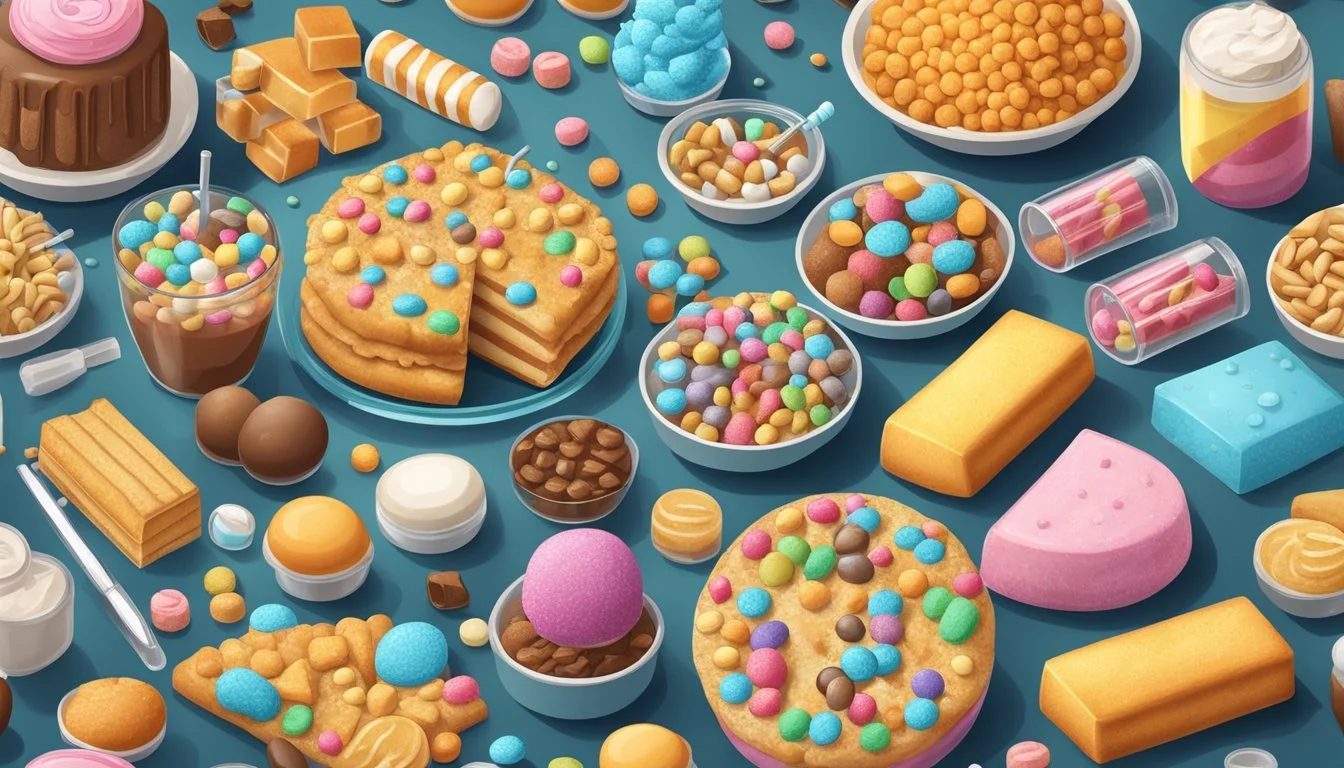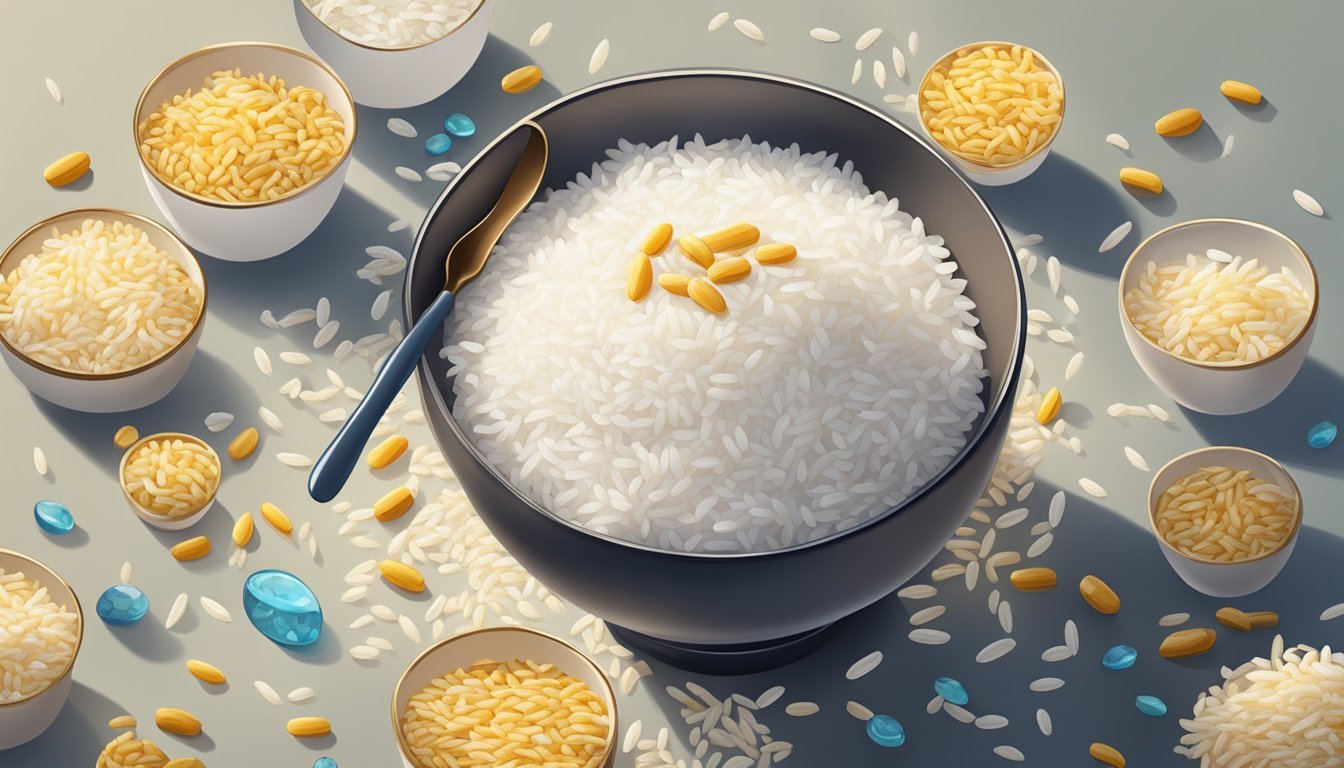Foods That Spike Insulin
Key Sources and Health Impacts
Understanding which foods can trigger high insulin responses is crucial for maintaining metabolic health. Insulin is a hormone that regulates blood sugar levels, and certain foods can cause significant spikes in insulin production. Managing these levels is essential for individuals dealing with conditions such as diabetes and insulin resistance.
Dietary choices directly impact insulin levels, and being aware of high insulin-index foods can help manage health more effectively. This article will explore various foods that are known to cause high insulin responses, shedding light on their effects and offering insights into better dietary decisions.
1) White Bread
White bread is a common staple in many diets. It is made from refined wheat flour, which undergoes extensive processing to remove the bran and germ. This results in bread that is light and has a longer shelf life but is low in fiber and essential nutrients.
Due to its processing, white bread is high on the glycemic index. Foods with a high glycemic index cause rapid spikes in blood glucose levels. This makes white bread a less ideal choice for individuals trying to manage blood sugar or insulin levels.
The insulin index of white bread is also quite high. This means that consumption of white bread triggers a significant increase in insulin secretion. For individuals with insulin resistance or type 2 diabetes, this can lead to challenges in maintaining balanced blood glucose levels.
In contrast, whole grain bread options are considered better for managing blood sugar. Whole grain alternatives retain more fiber and nutrients, offering a slower, more controlled release of glucose into the bloodstream.
Choosing white bread frequently can contribute to elevated insulin levels and potential health complications related to blood sugar management. Opting for whole grain varieties can be a healthier choice for regulating insulin and maintaining better overall health.
2) Sugary Cereals
Sugary cereals are a common breakfast choice but are often high in added sugars and low in essential nutrients. These cereals can cause a quick and significant spike in blood sugar levels. The body responds by releasing a large amount of insulin to manage the increased glucose.
Many popular sugary cereals are heavily processed. This processing often strips away beneficial fibers and proteins, exacerbating the rapid rise in blood sugar and insulin release. It's important to read labels carefully to understand the sugar content in these products.
Whole-grain options or cereals with added nuts and seeds can be better alternatives. These additions provide additional fiber and protein, which help to slow digestion and reduce the insulin spike. Choosing less processed cereals can be a valuable strategy for better blood sugar management.
3) Instant Oatmeal
Instant oatmeal often contains added ingredients like sugar and sweetened dried fruits. These additions can cause insulin levels to spike. While steel-cut and old-fashioned oats tend not to significantly elevate blood-glucose levels, the processed nature of instant oatmeal makes it more likely to impact insulin response.
The glycemic index (GI) of instant oatmeal is higher than less processed varieties. Foods with a high GI cause a quicker rise in blood sugar. This can be concerning for those managing conditions like diabetes, where stable blood sugar levels are crucial.
Another factor is the preparation time. Instant oatmeal is designed for quick cooking, which often involves breaking down the oats more thoroughly. This processing can contribute to faster digestion and absorption, leading to a rapid increase in blood sugar and insulin levels.
Choosing whole grain rolled or steel-cut oats is generally a better option for those concerned about insulin spikes. These types of oats are less processed and therefore have a lower glycemic impact compared to instant oats.
4) White Rice
White rice is a staple food in many cultures, but it is also known for its high glycemic index (GI). The high GI means white rice can cause rapid spikes in blood sugar levels after eating.
Studies have shown that diets high in white rice may increase the risk of developing type 2 diabetes. The high glycemic load (GL) of white rice contributes to this risk by reducing insulin sensitivity and β-cell function.
Replacing white rice with whole grains like brown rice can be beneficial. Brown rice has a lower glycemic index, which helps maintain stable blood sugar levels. Eating a variety of whole grains, along with other foods such as fruits, vegetables, legumes, and nuts, can further reduce the risk of diabetes.
In conclusion, it is advisable for individuals, especially those with diabetes or at risk of developing it, to limit their intake of white rice and focus on more nutritious alternatives.
5) French Fries
French fries are a common food that many people enjoy, but they are high in insulin-response potential. With a glycemic index score of 75, they can cause rapid spikes in blood sugar levels.
This high score indicates that the body converts the carbohydrates in French fries into glucose swiftly, triggering a substantial insulin release. Such a response can have significant effects on individuals with insulin sensitivity or diabetes.
Consuming French fries frequently carries risks. Research shows that eating three or more servings of French fries weekly is associated with a 19% higher risk of developing type 2 diabetes. This statistic is alarming for those trying to manage their blood sugar levels.
It's crucial to understand that not all fried foods impact blood sugar equally. For example, fried chicken without breading can have a less dramatic effect compared to French fries. This distinction is important for dietary planning.
6) Cookies
Cookies, particularly processed types, tend to have a high insulin index. This is due to their refined sugar and carbohydrate content, which can cause rapid spikes in blood sugar levels.
High-sugar cookies, such as chocolate chip and sugar cookies, typically rank high on the insulin index. This means they can quickly elevate insulin levels, which is something to be cautious about when managing blood sugar.
Some cookie mixes, like Miss Jones Chocolate Chip Cookie Mix, offer reduced sugar options that may be slightly better for insulin management. These mixes still contain processed ingredients but have modifications to reduce their overall sugar content.
Sugar-free or low-carb cookie mixes, like Lakanto Sugar Free Chocolate Chip Cookie Mix, are alternatives that may help in maintaining more stable insulin levels. Despite being marketed as healthier, it's critical to check nutritional labels for any hidden sugars or carbs.
7) Pastries
Pastries are a common treat, but they tend to be high in refined sugars and fats. This combination can cause significant spikes in insulin levels. They are often made from white flour, which has a high glycemic index, further contributing to insulin spikes.
Many pastries also contain added sugars. Sugar is a key factor that can lead to rapid increases in blood sugar, prompting a corresponding increase in insulin.
The presence of unhealthy fats in pastries can also affect insulin response. These fats may promote insulin resistance over time, making it harder to manage blood sugar levels.
Individuals looking to manage their insulin levels should be cautious with pastries. Opting for whole grain alternatives with lower sugar content can be a more balanced choice.
8) Sugary Drinks
Sugary drinks, including sodas, fruit juices, and sports drinks, are among the most significant contributors to high insulin levels.
These beverages contain a large amount of sugar, which is rapidly absorbed into the bloodstream. This quick absorption causes a sharp spike in blood glucose levels, prompting the body to release a substantial amount of insulin.
Regular consumption of sugary drinks can lead to persistent high insulin levels. Over time, this may contribute to insulin resistance, a condition where the body's cells become less responsive to insulin. Insulin resistance is a risk factor for developing type 2 diabetes.
Sugary drinks are also linked to weight gain, which itself can influence insulin sensitivity. The empty calories from these beverages provide no nutritional benefit and can lead to increased body fat.
Consuming sugary drinks frequently can cause fluctuations in blood sugar levels, leading to energy crashes and cravings for more sugar. Reducing intake of these beverages can help maintain stable insulin levels and improve overall health.
9) Candy
Candy is typically high in sugar and processed ingredients, which can lead to rapid spikes in blood sugar levels. For people with diabetes, monitoring carbohydrate intake is crucial, and many traditional candies are not diabetic-friendly.
When considering candy, portion control becomes vital. Fun-sized portions of some candies, like Peanut M&M's, which have around 11 grams of carbohydrates per serving, can be managed within a balanced diet.
Candies that include nuts, like Reese's Peanut Butter Cups, may have a slightly better impact on blood sugar levels due to added protein and fats. These components can slow down the absorption of sugar, preventing rapid spikes.
While indulging in candy, it is important to plan how it fits into the day's overall carbohydrate count. Including candy with meals can also help mitigate blood sugar spikes.
For those seeking sweet treats, there are sugar-free candy options available. These alternatives use sugar alcohols or artificial sweeteners, which are digested differently and may have less impact on blood sugar.
Being mindful of the glycemic index and insulin response of candies is essential. Opting for candies with lower glycemic indexes or those specially formulated for people with diabetes can help maintain better blood sugar control.
10) Pretzels
Pretzels are popular snacks known for their crunchy texture and salty flavor. They are typically made from refined white flour, which results in a high carbohydrate content. This composition can cause a rapid increase in blood sugar levels, making pretzels less ideal for those monitoring insulin levels.
Despite their low protein and fat content, pretzels contain wheat and yeast. Both ingredients have high glycemic indexes, contributing further to their impact on blood sugar. This is particularly concerning for individuals with conditions like diabetes, heart disease, or insulin resistance.
One nutritional downside of pretzels is their lack of significant vitamins and minerals. Although they provide some carbohydrates for energy, their nutritional value is relatively low. This makes it important to pair pretzels with more nutrient-dense foods to maintain a balanced diet.
Understanding Insulin Response
Insulin response is crucial in managing blood glucose levels and overall metabolic health. Factors such as the insulin index of foods and individual insulin sensitivity play significant roles.
How Insulin Works in the Body
Insulin is a hormone produced by the pancreas. It facilitates the uptake of glucose from the bloodstream into cells, where it is used for energy or stored as glycogen. After eating, blood glucose levels rise, triggering insulin release.
Foods with higher insulin indices cause a greater insulin spike. For example, pure glucose has a high insulin index, resulting in rapid insulin secretion. Conversely, avocados have a lower index, causing a minimal insulin response.
Factors Affecting Insulin Sensitivity
Insulin sensitivity varies among individuals and can be influenced by several factors. Diet plays a critical role; consuming foods with lower insulin indices helps maintain stable blood sugar levels. Exercise enhances insulin sensitivity by improving muscle glucose uptake.
Other factors include body weight, with obesity often leading to insulin resistance, and genetics, which can predispose individuals to varying sensitivity levels. Managing these factors through lifestyle choices can help optimize insulin response and reduce the risk of metabolic disorders.
Nutritional Mechanisms
Nutritional mechanisms play a crucial role in regulating insulin response. Different macronutrients, such as carbohydrates and proteins, impact insulin levels through various pathways. Understanding how these nutrients interact with insulin is essential for managing insulin resistance and enhancing glycemic control.
Carbohydrates and Insulin
Carbohydrates significantly impact insulin response. When consumed, they are broken down into glucose, increasing blood sugar levels.
The body responds by releasing insulin to facilitate glucose uptake by cells for energy or storage. High-glycemic index (GI) carbohydrates cause rapid spikes in blood glucose, leading to increased insulin secretion.
Sources of high-GI carbohydrates include:
White bread
Sugary cereals
Soft drinks
Conversely, low-GI carbohydrates result in a slower, more gradual increase in blood sugar, which can help maintain better insulin sensitivity. Examples include whole grains, legumes, and most fruits and vegetables.
Proteins' Role in Insulin Response
Proteins also influence insulin response but through different mechanisms. Proteins stimulate insulin secretion by increasing amino acid levels in the blood, which triggers pancreatic beta cells to release insulin.
High-protein diets have demonstrated effectiveness in improving insulin sensitivity, particularly in individuals with pre-diabetes and diabetes.
Key sources of protein include:
Fish
Eggs
legumes
Specific amino acids, such as leucine, play a critical role in enhancing insulin action. Additionally, combining proteins with carbohydrates can moderate blood sugar spikes, leading to a more balanced insulin response.
Common Misconceptions
Many people believe that certain foods are "high in insulin." This idea stems from misunderstandings about insulin's role and how various foods impact insulin levels.
A common misconception is that eating sugar directly increases insulin production to dangerous levels. Sugar does cause a spike in insulin, but it doesn’t contain insulin. The body's pancreas produces insulin in response to carbohydrate intake.
Another myth: Only diabetics need to monitor their insulin. While diabetics must be vigilant, everyone's insulin levels fluctuate with their diet. High-glycemic foods cause higher spikes compared to low-glycemic ones, impacting overall health.
Some also think insulin-inducing foods must be avoided entirely. Foods that trigger insulin release, like fruits, also provide essential nutrients. It's critical to balance these foods with fiber and protein to mitigate sharp insulin spikes.
People sometimes assume that insulin spikes are inherently bad. For healthy individuals, insulin is necessary for energy distribution. Problems arise with insulin resistance, not the insulin itself.
The idea of "insulinogenic foods" may confuse people. Foods rich in protein, like dairy and lean meats, stimulate insulin but in beneficial ways. They help regulate blood sugar without causing major spikes.
By clarifying these misconceptions, it's easier to understand insulin's role in a balanced diet.









